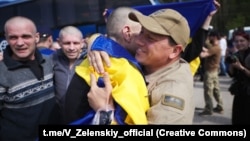Russia and Ukraine launched the biggest prisoner swap since the start of Russia's full-scale invasion, exchanging hundreds of soldiers and civilians in a process that was set to continue over the weekend, officials in both countries said on May 23.
"We are bringing our people home," Ukrainian President Volodymyr Zelenskyy said in a post on Telegram. "The first part of the agreement on the 1,000-for-1,000 exchange has been implemented."
Zelenskyy said 390 people from each side were exchanged and the swap was expected to continue on May 24-25. That number included 270 soldiers and 120 civilians, Russian and Ukrainian officials said.
Hours earlier, US President Donald Trump said Ukraine and Russia had "just completed" the swap, which has been in the works since peace talks in Istanbul one week ago, and that it would "go into effect shortly."
"Congratulations to both sides on this negotiation," Trump wrote on his Truth Social platform. "This could lead to something big???"
A day earlier, Zelenskyy said the agreement was “perhaps the only real result” of the 90-minute meeting between Ukrainian and Russian negotiators in Istanbul on May 16 -- the first direct peace talks between Ukrainian and Russian officials since shortly after Moscow launched its full-scale invasion of Ukraine in February 2022.
The exchange took place at Ukraine's border with Belarus, a Russian ally that has supported the invasion without sending its own troops to fight in the war.
Three women were among the 390 Ukrainians returning home, Ukraine's Coordination Headquarters for the Treatment of Prisoners of War said on Telegram.
The Russian Defense Ministry said that the 120 civilians released by Ukraine included residents of the Kursk region, where Ukrainian forces held a swath of territory for months after a surprise invasion last August.
A Ukrainian organization involved in exchanges said that 70 of the people swapped by Ukraine were Ukrainians who have been convicted of crimes such as collaborationism, treason, and terrorism and had expressed the desire to be sent to Russia.
An exchange of 1,000 people from each side would be the largest of several prisoner swaps since the start of the full-scale invasion. Previous exchanges have not led to tangible progress on ending the war.
Russia has rejected calls by Ukraine, the United States, and European countries for a 30-day cease-fire, and no new meeting has been scheduled in the wake of the negotiations in Istanbul.
In a Truth Social post following a phone call with Russian President Vladimir Putin on May 19, Trump said that Russia and Ukraine would "immediately start negotiations" toward a cease-fire and an end to the war. He suggested the Vatican as a possible venue for further talks.
Russian Foreign Minister Sergei Lavrov threw cold water on that idea on May 23 and emphasized that no date for a new meeting had been set.
"Many people are fantasizing about when and where it will take place. We don't have any ideas right now," Lavrov said in remarks at the Diplomatic Academy in Moscow, adding that it would be “a bit inelegant” for Russia and Ukraine, which are predominantly Orthodox Christian, to “use a Catholic platform” for the talks.
"I think it would not be very comfortable for the Vatican itself to host delegations from two Orthodox countries in these circumstances," Lavrov said.
Lavrov added that Russia will present Ukraine with a draft document outlining its terms for a potential long-term peace agreement as soon as the prisoner exchange is completed.
Ukraine and European governments have accused Russia of conditioning a cease-fire on unacceptable demands and failing to negotiate in good faith. Many analysts say Putin has not given up on the goal of subjugating Ukraine.
One of several major sticking points is the Kremlin's demand that Ukraine withdraw its forces from four partially Russian-occupied mainland regions that Moscow baselessly claims belong to Russia. Zelenskyy has stressed that Ukraine will not withdraw troops from its own territory.













